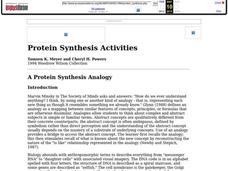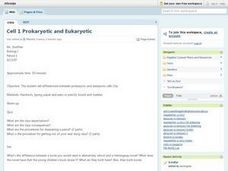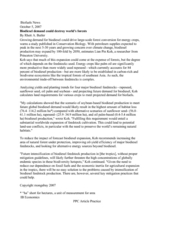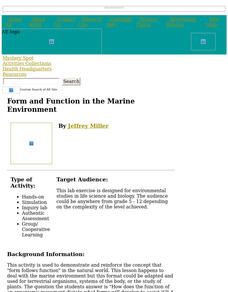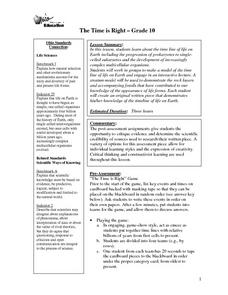Curated OER
Protein Synthesis Activities
Young scholars compare the process of protein synthesis in an analogy. They simulate the process of protein synthesis kinesthetically using index cards and write a paragraph to explain the process.
Curated OER
Coevolution: A Simulation
Students participate in a demonstration in which they must attempt to suck liquid from varying containers with straws of varying sizes. They discuss the concept of coevolution and see why this activity illustrate the coevolution of...
Curated OER
Cell 1 Prokaryotic and Eukaryotic
Young scholars differentiate between prokaryotic and eukaryotic cells. They examine pictures of prokaryotes and eukaryotes and write down the differences between the two. They complete a Venn Diagram on the cells.
Curated OER
Primary And Secondary Succession
Students cover the topics of primary and secondary succession with interest to its ties in the study of ecosystems. They study how the introduction of an insect can effect the ecological balance. Students make predictions and write them...
Curated OER
Butterfly Identification Exercise
Learners examine the various species of butterflies found in Idaho. Using a visual key, they compare and contrast different butterflies with their own sample. In groups, they identify the common and latin name along with its diet and...
Curated OER
Field Crops in the Agro-ecosystem
Ninth graders explore how to apply ecological analysis to cropping systems. For this agro-ecosystem lesson students study management practices including soil and fertility.
Curated OER
Horticulture Crops in the agro-ecosystem
Ninth graders apply ecological analysis to fruit and vegetable production systems. In this horticulture lesson students learn about different management practices.
Curated OER
Biodiesel Demand Could Destroy World's Forests
In this global issues worksheet, students read a 1-page article about biodiesel demand then write PPC articles that address the costs of biodiesel use.
Curated OER
Genetic Engineering
Students examine the advantages and disadvantages of genetic engineering. In this genetics instructional activity students simulate the genetic engineering of a human insulin gene.
Curated OER
The Lesson: Species Under Threat
Students consider the plight of endangered species. In this global studies lesson, students research selected websites about endangered animals and identify global issues that contribute to their demise.
Curated OER
Fiber of Life
Students examine the importance of plants to individuals and society through a multi-discipline set of activities. They observe and draw different leaf structures and then create a book about trees and photosynthesis. They explore ways...
Curated OER
Sun Seeking Plants
Students investigate the story "The Tiny Seed" by Eric Carle. This story is used to introduce the children to the concept that seeds change and grow into plants when conditions in the environment including temperature, light, water and...
Curated OER
Water and Ice
Students observe what happens to water as it goes from a solid to a liquid. In this exploratory lesson plan students gain an understanding for the water cycle while working in groups observing what happens to water as it changes...
Curated OER
This Life Stinks
High schoolers study how organisms that live in cold seep communities get energy from methane. For this organism lesson students write a brief report and identify oxidation reduction reactions and explain if these are dependent of...
Curated OER
Coastal Ecology of the Bahamas
Sixth graders investigate the Bahamas through presentations and charts. In this ecology lesson, 6th graders utilize their library and Internet to research the life forms and species that inhabit the Bahamas. Students observe...
Curated OER
Animals of the Fire Ice
Students study ice worms and describe how they interact with other species. In this methane hydrate lesson students study ice worms and hydrate shrimp to learn their behavior and can participate in an optional activity.
Curated OER
Life is Weird
Students describe features of cold seep communities and list organisms that can be found in these communities. For this exploratory lesson students complete an activity and describe the process of chemosynthesis.
Curated OER
Form and Function in the Marine Environment
Students study the relationship of form and function in the marine environment.
Curated OER
Utah's Amazing Ecosystems
Middle schoolers investigate the various ecosystems of Utah. They define key vocabulary terms, conduct research, and create an informational report on a selected ecosystem of Utah.
Curated OER
The Sights and Sounds of Orcas
Students investigate the orca whale. They participate in an online Webquest, listen to whale vocalizations online, answer discussion questions, and locate and read newspaper articles on marine mammals and orca whales.
Curated OER
Land Use Issues
Learners observe and describe the properties of rocks and their significance relationship in the environment. They explain the implications of destroying habitats and the importance of rebuilding them.
Curated OER
The Time is Right
Tenth graders study the timeline of life on Earth. They learn about the progression of prokaryotes to single celled eukaryotes and the development of increasingly complex multicellular organisms.
Curated OER
Electrophoretic Analysis: DNA Fingerprinting and Evolutionary Divergence
Students examine the principles of electrophoresis. They evaluate both the agarose and polyacrylamide system of molecular separation. In order to bring the concepts of genetics and evolution full circle from DNA to protein, students...
Curated OER
An Enzyme- Substrate Model
Students explore reaction rates of an enzyme-mediated reaction. They examine the effects of environmental variables on enzyme function. Students collect, graph, and analyze data relating to the reaction.
